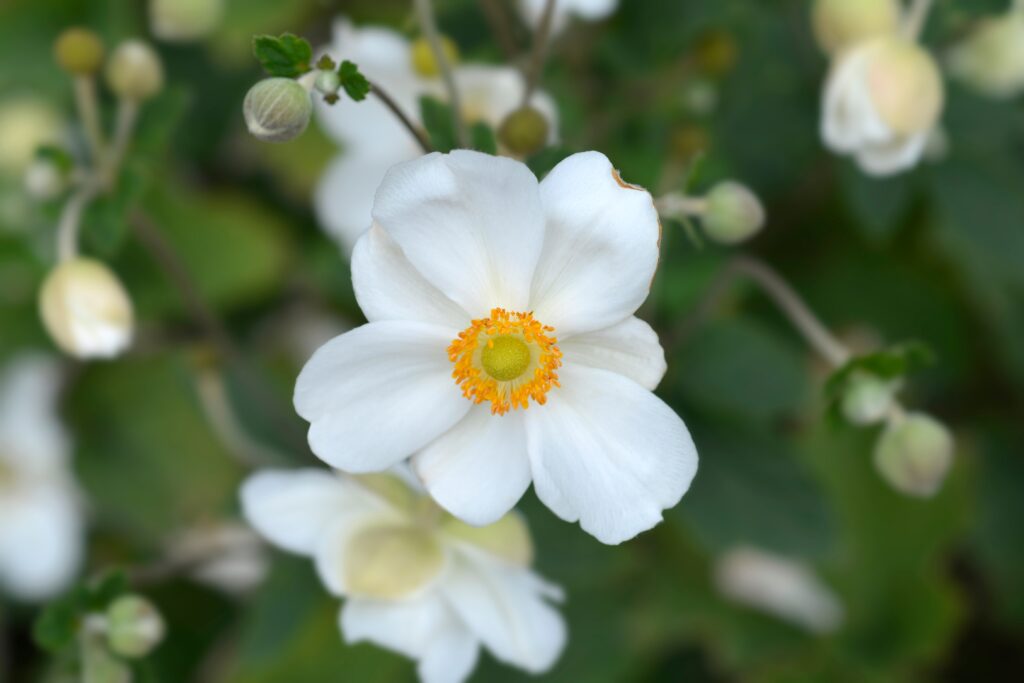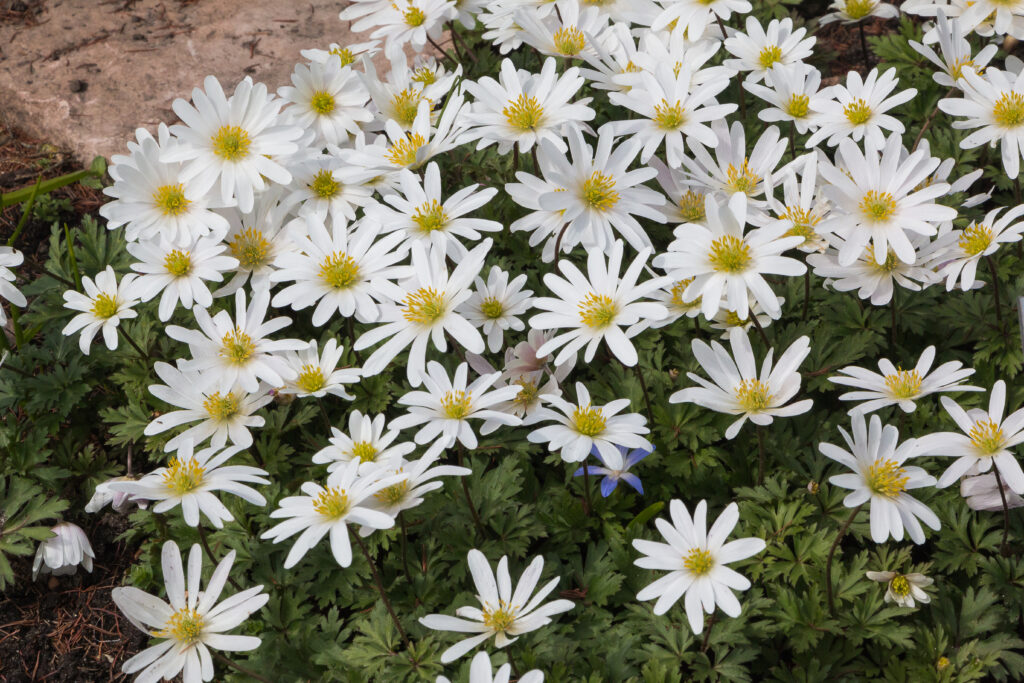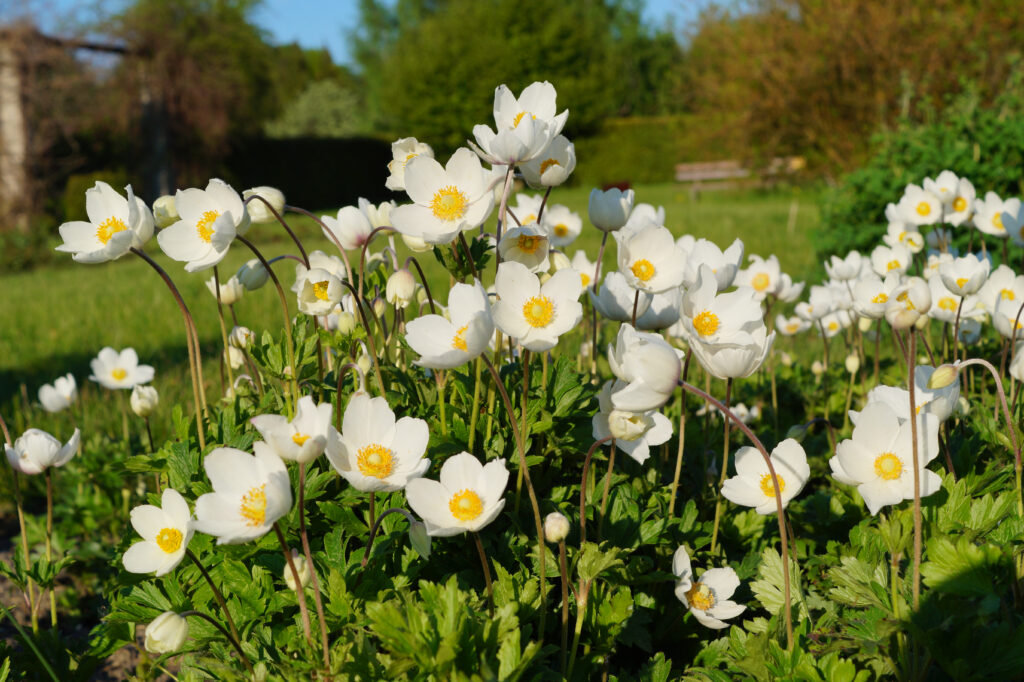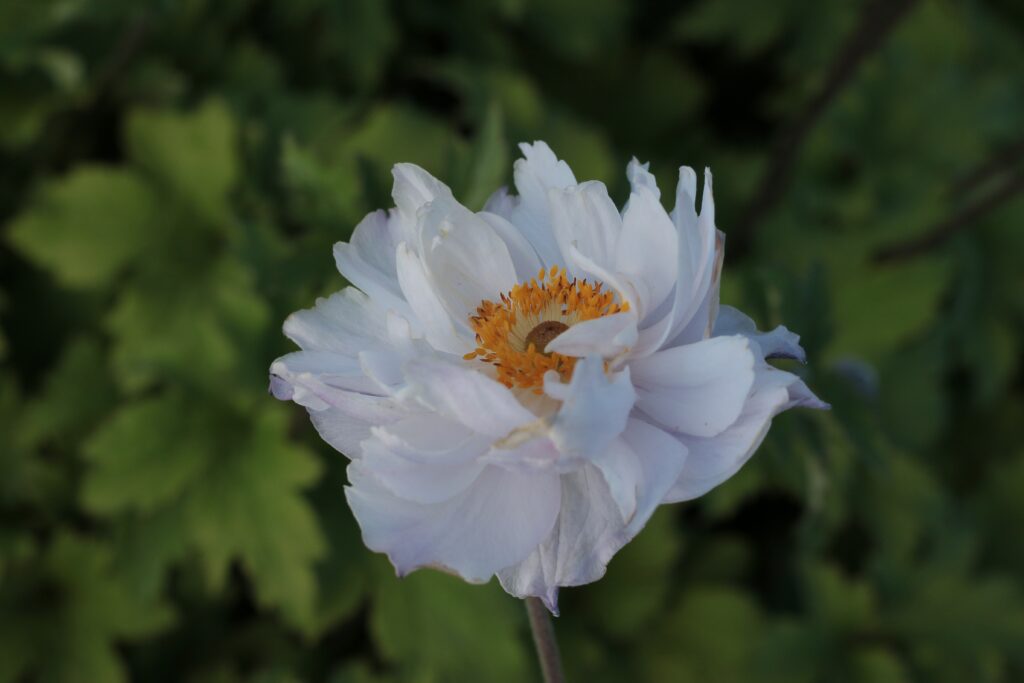White anemones are the second most common type of anemones, behind bluish-violet ones. These flowers grow anywhere in the world with temperate or subtropical climates except for Australia, New Zealand, and Antarctica. Their name, “daughter of the wind,” comes from how the wind helps its bulbs open and blows away dead petals as well.
Anemones have three main groups:
- Tuberous or rhizomatous species that grow in forests and alpine meadows and flower in the spring
- Species with tuberous roots that flower in the spring and summer in hot, dry areas
- Species with fibrous roots, which grow best in moist, shady areas, blooming in the summer and autumn
No matter which group they belong to, white anemones are sure to class up floral arrangements and wedding bouquets and make your garden more elegant. They are beautiful, delicate flowers that are easy to care for and can add beauty to any environment.
We’ll provide you with a list of the prettiest varieties and some advice on how to care for them to yield stunning, voluptuous flowers. Since it’s a perennial flower, any competent gardener will have anemones at hand for many years after planting them. Even if you’re uninterested in gardening, you’ll know what to order when arranging party decorations.
Types of White Anemones
Anemones come in various colors and shapes, yet they all have poppy-like flowers that sway with the wind. Since this flower has a plethora of species and we can’t cover all of them, we’ve made a selection of the prettiest white varieties.
Anemone coronaria — ‘The Bride’

Because they last several weeks in vases, the
Anemone coronariais perfect as a cut flower.
©Photo_Traveller/Shutterstock.com
This variety’s name gives away its most widespread use, and it’s no surprise given its simple but dramatic aspect. These give wedding bouquets a fresh, bright look with crisp white petals and a beautiful pale green center. It grows easily in moist, well-drained soil that has plenty of sunlight.
If you’re in an area where the winter isn’t harsh, you can plant it in the fall, and it’ll bloom in early spring. Otherwise, planting it in the spring or early summer is best. Coronaria anemones are excellent cut flowers, lasting several weeks in a vase.
Anemone x hybrida — ‘Honorine Jobert’

The Honorine Jobert is perfect for meadows and coastal gardens.
©Nahhana/Shutterstock.com
This white anemone is an ancient variety beloved for its vigor and elegance. Its flowers have a sturdy base forming dense foliage and tall branches reaching 4 feet tall. They exhibit slightly cupped white flowers with contrasting yellow stamens, perfect for meadows or coastal gardens.
You should plant this cultivar in moist, well-drained soil rich in organic matter, ensuring it doesn’t get overwhelming sunlight. Although not invasive, these plants can take over your garden if left unattended.
Anemone blanda — ‘White Splendour’

The White Splendour is ideal under shrubs and trees.
©Svetlana Mahovskaya/Shutterstock.com
This award-winning variety honors its name with its pure white petals, yellow centers, and pink-tinted backs. It has small foliage at its base, and its flowers spread out, forming a carpet of flowers. This anemone is ideal for naturalizing under shrubs and trees.
You can plant it in the fall because of its ability to survive the winter as long as it has partial shade and moist soil, and it will blossom abundantly in early spring.
Anemone sylvestris

Another name for the
Anemone sylvestrisis the snowdrop anemone.
©Mariola Anna S/Shutterstock.com
Also known as “Snowdrop Anemone,” this variety can brighten up shaded areas thanks to the contrast between its dark green foliage and cup-shaped white flowers. Once the petals fall off, white, wooly seed heads will remain, making the plant’s beauty last longer.
Since it’s pest- and disease-free and resistant to rabbits and deer, it’s a low-maintenance addition to any garden as long as it’s in medium-moisture soil and gets little sunlight.
Anemone x hybrida — ‘Frilly Knickers’

The Frilly Knickers anemone is a relatively new breed.
©Lidia Kovacs/Shutterstock.com
A new breed, this variety doesn’t tend to spread around your garden, opting to stay in place. Its frilled, white petals have a tinge of purple and grow on top of each other around a golden center. This plant is loved by butterflies and bees, which are drawn to the nectar-rich blooms.
It can bloom in early fall in moist, fertilized soil that gets more shade than sunlight. It is easy to grow and full of flowers, creating a fantastic, almost romantic display.
Growing and Caring for White Anemones
Aside from the particular soil and sunlight instructions we’ve given you, the following indications apply to any cultivar of this flower.
If you have a variety that grows tall, you should support the branches so they don’t bend or break. You’d do well in picking out large corms to ensure a healthier plant that grows more flowers. Before planting, always soak the corms in warm water for four hours, which will help the sprouts grow faster.
You should deadhead the flowers after they fade but keep the foliage intact to accumulate energy for the following year. If your anemone isn’t winter-hardy, you can dig out the corms when the foliage dies, dry them, and replant them in the spring.
Up Next:
- Anemone vs. Poppy: What is the Difference?
- Discover: 4 Animals That Pollinate (Other Than Bees)
- What Flowers Attract Butterflies?
The photo featured at the top of this post is © Svetlana Mahovskaya/Shutterstock.com
FAQs (Frequently Asked Questions)
What are some common diseases that affect anemones?
Few pests attack anemone flowers, which are distasteful to deer and rodents. You should look out for fungal diseases such as downy mildew, powdery mildew, Rhizoctonia, and viral diseases such as Anemone mosaic or Cucumber mosaic. Assess the situation and consult with an expert to learn the necessary measures to heal your flowers.
How do I know which type of white anemone is best for my garden?
To answer this question, you must first learn which plant hardiness zone you’re in, a ranking of winter temperatures that determines which plants can survive the cold season. Some anemones can persist in zone 5 or zone 6, but most will thrive in zones 7 to 10. Your local gardener can help you pick the correct variety to guarantee a successful harvest.
What are the benefits of growing white anemones?
In addition to their perennial beauty, anemones are easy to grow and will attract pollinators during the initial stages of spring. Their pollen-rich flowers will also attract predatory insects, which can feed on the few pests that attack them, saving you the trouble of applying pesticides.
How often should I fertilize anemones?
You should fertilize your anemones when their buds develop, but it also depends on the type of fertilizer. If you’re using a slow-release fertilizer, this first application of the product will be enough to last between 3 and 6 months. In the case of quick-release fertilizers, you should give them a second helping one or two months later to encourage blossoming.
Thank you for reading! Have some feedback for us? Contact the AZ Animals editorial team.






